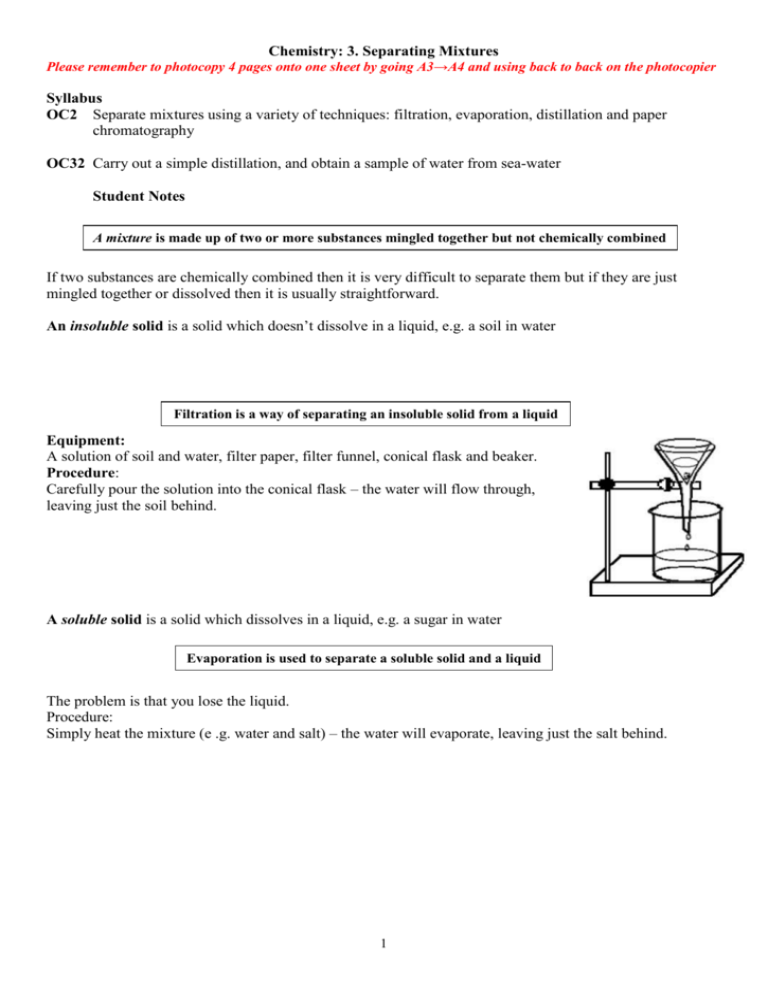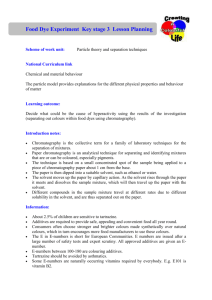3. Separating Mixtures
advertisement

Chemistry: 3. Separating Mixtures Please remember to photocopy 4 pages onto one sheet by going A3→A4 and using back to back on the photocopier Syllabus OC2 Separate mixtures using a variety of techniques: filtration, evaporation, distillation and paper chromatography OC32 Carry out a simple distillation, and obtain a sample of water from sea-water Student Notes A mixture is made up of two or more substances mingled together but not chemically combined If two substances are chemically combined then it is very difficult to separate them but if they are just mingled together or dissolved then it is usually straightforward. An insoluble solid is a solid which doesn’t dissolve in a liquid, e.g. a soil in water Filtration is a way of separating an insoluble solid from a liquid Equipment: A solution of soil and water, filter paper, filter funnel, conical flask and beaker. Procedure: Carefully pour the solution into the conical flask – the water will flow through, leaving just the soil behind. A soluble solid is a solid which dissolves in a liquid, e.g. a sugar in water Evaporation is used to separate a soluble solid and a liquid The problem is that you lose the liquid. Procedure: Simply heat the mixture (e .g. water and salt) – the water will evaporate, leaving just the salt behind. 1 Distillation Distillation can be used to separate a soluble solid and a liquid (and you get to keep both) Distillation can be used to separate two miscible liquids with different boiling points (and you get to keep both) Two miscible liquids are liquids which mix together, e.g. alcohol and water. A: Thermometer B: Water out to sink C: Condenser D: Cold water in E: Tripod stand F: Bunsen burner To obtain a sample of water from sea-water using simple distillation Procedure: 1. Set up as shown above. 2. Part C is called a condenser; it has an outer tube which carries cold water which causes the water vapour passing through the inner tube to condense back into a liquid. 3. Cold water goes in through D and out through B. 4. The round-bottom flask above the Bunsen burner contains sea-water. Result: The water evaporates from the round-bottom flask, travels through the condenser where it condenses and flows into the beaker as pure water. 2 Chromatography Chromatography is used to separate a mixture of dies in an ink Procedure 1. Put an ink spot just above the water line as shown. 2. Water rises up through the chromatography paper and takes the various colours which were in the ink spot to different heights. 3 Exam Questions 1. [2006] How would you show that water contains dissolved solids? 2. [2010 OL] [2007 OL] (i) What is the name given to the separation technique shown in diagram? (ii) Name two substances which could be separated using this technique. (iii)Name the piece of equipment labelled A. (iv) Would you expect to find the solid in A or B at the end of the experiment? 3. [2009][2008 OL] Describe, with the aid of a labelled diagram, how you could carry out an experiment to separate an insoluble solid from a liquid. Use the headings below. Labelled diagram, Equipment, Procedure, Result 4. [2010][2012 OL] A mixture of sand and salt was stirred up with water and then filtered as shown in the diagram. (i) Substance A was retained by the filter paper. Name A. (ii) Substance B was passed through the filter paper. Name one constituent of B. Distillation 5. [2009] [2007][2008 OL] [2006 OL] (i) Name the separation process shown in the diagram. (ii) Name the item labelled C in the diagram. (iii)Identify the part A or B of item C which is connected to the cold tap. (iv) How could you show that the water collected contains no salt? (v) Name a constituent of seawater that does not move from flask A to flask B. 6. [2009 OL][2007 OL] [2012 OL] Separation techniques are very important in chemistry. The apparatus in the diagram below was used to separate a mixture of water and a dissolved dye. Study the diagram. (i) Complete the table correctly matching the labels A – F in the diagram with words/phrases in the table. (ii) What is the name given to the separation technique shown in the diagram above? (iii)A colourless liquid was collected in container E during the separation. Name a substance you could use to show that this liquid was water. (iv) What colour change is observed in this test to show that water is present? 4 Chromatography 7. [2011 OL] [2008 OL] A solution of dye can be separated into its constituent colours using the method shown in the diagram. Study the diagram and answer the following questions. (i) What name is given to this type of separation? (ii) Name a suitable solvent for this investigation (iii)What would you expect to notice on the piece of chromatography paper after some time? (iv) The ink spot is placed on the chromatography paper just above the level of the solvent. Why? 8. [2008] (i) Describe an experiment to investigate the composition of inks in markers containing water-soluble inks, to see if they are a single-colour ink or a mixture of coloured inks. (ii) On completion of the experiment how is it possible to distinguish between a marker containing a pure single-colour ink and a marker containing mixture of coloured inks. 9. [2006] A spot of water-soluble ink was put on a piece of chromatography paper and set up as shown in the diagram. The ink used was a mixture of different coloured dyes. (i) What happens to the ink spot as the water moves up the paper? (ii) What would happen to a spot of water-soluble ink consisting of a single coloured dye if it were used in the above experiment? 10. Paper chromatography was used to find the composition of brown ink in a pen. The same liquid, paper and pen were used in each of the three experiments shown. They were started at different times, C first then B and finally A. (i) Why is the ink dot above the level of the liquid in each beaker? (ii) What caused the dots of ink on the papers B and C to spread upwards? (iii)Why were colours, other than brown, seen in B and C as the ink moved up the paper? 5 11. [2011 OL] Separation techniques are very important in chemistry. A group of students carried out an experiment to separate salt from rock salt (impure salt containing sand and clay). A number of the pieces of equipment they used are shown below. Answer the following questions on this experiment. (i) Which of the pieces of equipment A, B, C or D was used to grind up (crush) the rock salt at the beginning of the experiment? The rock salt was placed in a container and hot water added. The mixture was added to allow the salt to dissolve. (ii) Name the piece of equipment (container) in which the crushed rock salt was placed before the hot water was added. (iii)Name the piece of equipment that was used to heat the water. The salt and water was separated from the insoluble impurities (dirt) using the apparatus shown on the right. (iv) What name is given to the separation technique? (v) The salt and water was collected at X. Explain why the insoluble impurities (dirt) were held at Y. (vi) To get the salt from the mixture of salt and water the water was removed. This could be done be either evaporation or distillation. The apparatus used for these techniques is drawn below. Identify each technique. 6 Exam Solutions 1. Evaporate/boil off all the water You will be left with a layer of residue (solid). 2. (i) Filtration (ii) Soil and water (iii)Funnel (iv) A – the funnel 3. Diagram: see diagram Equipment: Filter paper, funnel, beaker, retort stand. Procedure: Pour the mixture through the funnel. Water drips through Result: Soil remains in the filter paper 4. (i) Sand (ii) Salt and water 5. (i) Distaillation (ii) Condenser (iii)Part B (iv) Evaporate the water and note that there is nothing left behind. (v) Salt 6. (i) A: Round bottomed flask B: Thermometer C: Condenser D: Cold water in E: Beaker F: Bunsen (ii) Distillation (iii)Cobalt chloride paper/ (anhydrous) copper sulphate (iv) Blue cobalt chloride paper turns to pink / white copper sulphate turns to blue 7. (i) Chromatography (ii) Water (iii) Colours appear (separation) (iv) There would be no separation 8. (i) Set up as shown, using chromatography (filter) paper Put the ink spots on the paper above the water The water rises up the paper, bringing the various inks with it. (ii) There is no separation for an ink composed of a single colour but separation does occur for an ink composed of a mix of coloured inks. 9. (i) Colours appear (separation) (ii) There would be no separation 10. (i) Because the ink dot would dissolve into the liquid/ ink would not rise up the paper/ ink soluble (ii) They were carried up by the liquid/ capillarity (iii)The brown ink was a mixture of inks/ made up of different colours 11. (i) D: mortar and pestle (ii) Beaker (iii)Bunsen burner (iv) Filtration (v) Dirt particles are too big to pass through the pores, the dirt doesn’t dissolve (vi) Evaporation, distillation 7 Other test questions 1. Describe briefly with the aid of a diagram how to separate alcohol from water by distillation. 2. Alcohol and water can be separated by distillation. What is the difference between the two liquids that allows them to be separated by this technique? 3. (i) The ink in a biro is an example of a mixture. Explain what is meant by a mixture. (ii) What technique, in a laboratory, could be used to separate the mixture of pigments in biro ink? 8





